Caryn’s Thoughts
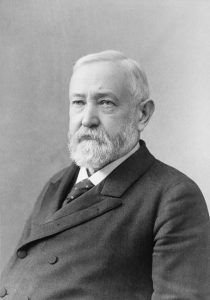 Sometimes, a business starts up and then can’t make a go of it. Whatever the reason, things just don’t work out. Such was the case with a 1690 newspaper called Publick Occurrences Both Forreign and Domestick. This newspaper was published for the first and last time on September 25, 1690, making it the shortest business on record.
Sometimes, a business starts up and then can’t make a go of it. Whatever the reason, things just don’t work out. Such was the case with a 1690 newspaper called Publick Occurrences Both Forreign and Domestick. This newspaper was published for the first and last time on September 25, 1690, making it the shortest business on record.
It would seem like such a business venture wouldn’t hold a very significant place in history, but it did have one distinction that gave it an important place. It was the first multi-page newspaper published in the Americas. Before then, single-page newspapers, called broadsides, were published in the English colonies and printed in Cambridge in 1689. The first edition of Publick Occurrences was published in Boston, then a city in the Dominion of New England, and was intended to be published monthly, “or, if any Glut of Occurrences happen, oftener.” It was printed by American Richard Pierce of Boston, and it was edited by Benjamin Harris, who had previously published a newspaper in London. The paper contained four 6 by 10 inch pages, but filled only three of them…not bad for a new newspaper.
The second edition was never printed because the paper was shut down by the Colonial government on September 29, 1690, who issued an order as follows: “Whereas some have lately presumed to Print and Disperse a Pamphlet, 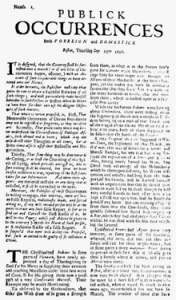 Entitled, Publick Occurrences, both Forreign and Domestick: Boston, Thursday, September 25th, 1690. Without the least Privity and Countenace of Authority. The Governour and Council having had the perusal of said Pamphlet, and finding that therein contained Reflections of a very high nature: As also sundry doubtful and uncertain Reports, do hereby manifest and declare their high Resentment and Disallowance of said Pamphlet, and Order that the same be Suppressed and called in; strickly forbidden any person or persons for the future to Set forth any thing in Print without License first obtained from those that are or shall be appointed by the Government to grant the same.”
Entitled, Publick Occurrences, both Forreign and Domestick: Boston, Thursday, September 25th, 1690. Without the least Privity and Countenace of Authority. The Governour and Council having had the perusal of said Pamphlet, and finding that therein contained Reflections of a very high nature: As also sundry doubtful and uncertain Reports, do hereby manifest and declare their high Resentment and Disallowance of said Pamphlet, and Order that the same be Suppressed and called in; strickly forbidden any person or persons for the future to Set forth any thing in Print without License first obtained from those that are or shall be appointed by the Government to grant the same.”
Of course, in those days, we were not an independent nation, and the Constitution did not exist. Freedom of the press…or any of the other freedoms that our soldiers and our nation have fought to give us, didn’t exist either. England was the ruler and the law, and we had to obey…for a time. Soon enough, change would come, as would freedom, and every kind of newspaper and other types of information sources imaginable.
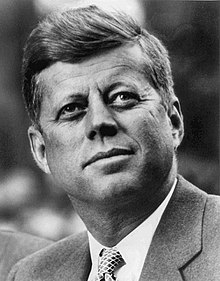 When President Kennedy was assassinated in Dallas, Texas on November 22, 1963, I was just a little girl of 8 years. I vividly remember how I found out about it. A neighbor girl came running across the street from her house to mine. I was on my way to meet her. It was in the middle of the street that I heard the news…our President had been assassinated. I was horrified, like most Americans were that day. It all seemed too impossible to comprehend. I knew nothing of politics back then, of course, I just knew that something horrible had happened to my country…the whole country. A nation doesn’t lose a president for any reason and not suffer from that loss. The loss of the president…the only president lost during office in my entire lifetime…not that attempts weren’t made or threatened, was so shocking to me. It’s something I will never forget.
When President Kennedy was assassinated in Dallas, Texas on November 22, 1963, I was just a little girl of 8 years. I vividly remember how I found out about it. A neighbor girl came running across the street from her house to mine. I was on my way to meet her. It was in the middle of the street that I heard the news…our President had been assassinated. I was horrified, like most Americans were that day. It all seemed too impossible to comprehend. I knew nothing of politics back then, of course, I just knew that something horrible had happened to my country…the whole country. A nation doesn’t lose a president for any reason and not suffer from that loss. The loss of the president…the only president lost during office in my entire lifetime…not that attempts weren’t made or threatened, was so shocking to me. It’s something I will never forget.
After the assassination, there was much controversy about what happened. Immediately…as always happens when anything big happens, there is a special commission appointed to find out what happened. I can see how that is important sometimes, but I don’t know that I think these commissions are always unbiased. As with most events such as these, there were, and still are, many people who do not think that Lee Harvey Oswald acted alone…or that he was even involved at all. Seven days after the assassination, Johnson appointed the President’s Commission on the Assassination of President Kennedy to investigate Kennedy’s death, and on this day, September 24, 1964, the Warren Commission, headed up by Chief Justice Earl Warren, gave their report to President Lyndon B 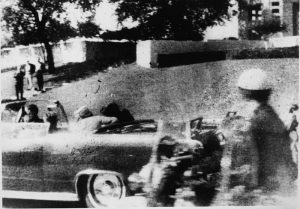 Johnson, who had been vice-president to President Kennedy, and therefore became president upon his death.
Johnson, who had been vice-president to President Kennedy, and therefore became president upon his death.
Following the report, those who disagreed thought that the whole thing was a conspiracy. The conspiracy theories were many, including the Mob, Cuban exiles, military leaders, the secret service, and even Lyndon Johnson. The Warren Commission concluded that Oswald was the “lone gunman” in the assassination, but that failed to satisfy some who witnessed the attack and others whose research found conflicting details in the commission’s report. Critics of the Warren Commission’s report believed that additional ballistics experts’ conclusions and a home movie shot at the scene disputed the theory that three bullets fired from Oswald’s gun could have caused Kennedy’s fatal wounds as well as the injuries to Texas Governor John Connally, who was riding with the president in an open car as it traveled through Dallas’ Dealey Plaza that day. Eventually, another congressional investigation was conducted in 1979, but that committee reached the same conclusion as the Warren Commission. During its almost year-long investigation, the Warren Commission reviewed reports by the Federal Bureau of Investigation, Secret Service, Department of State and the attorney general of Texas. It also pored over Oswald’s personal history, political affiliations 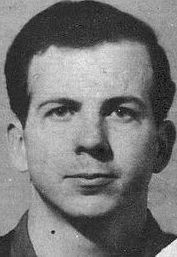 and military record. The Warren Commission listened to the testimony of 552 witnesses and even traveled to Dallas several times to visit the site where Kennedy was shot.
and military record. The Warren Commission listened to the testimony of 552 witnesses and even traveled to Dallas several times to visit the site where Kennedy was shot.
The enormous volume of documentation from the investigation was placed in the National Archives and much of it is now available to the public. Access to Kennedy’s autopsy records, though, are highly restricted. To view them requires membership in a presidential or congressional commission or the permission of the Kennedy family. I am one of those who find the conclusion of the Warren Commission to be…very simplistic, and hard to believe. I have watched several documentaries about the assassination, including the video of the actual event, and it just doesn’t make sense. Be that as it may, the commissions have spoken, and nothing more will ever be done about it. The many people involved are all gone now, so there is no one to say what really happened. So we only know what we have been told, but most of it doesn’t make sense to me.
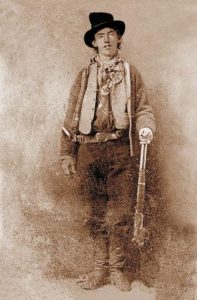 Every family has it’s black sheep, and I have recently found out that one of mine is that my 7th cousin 3 times removed is Billy the Kid. Most of the people in my family tree are good people, and many are presidents and even royalty, but there are still a few of them who were…a bit on the wild side. Billy the Kid was one of those. On September 23, 1875, William Henry McCarty was arrested for the first time after stealing a basket of laundry. I can’t imagine why he chose a basket of laundry, but that was his entry into the world of crime. The jails back then weren’t super secure, so Billy the Kid broke out of jail, and roamed the West, eventually earning a reputation as an outlaw and murderer and a rap sheet that allegedly included 21 murders.
Every family has it’s black sheep, and I have recently found out that one of mine is that my 7th cousin 3 times removed is Billy the Kid. Most of the people in my family tree are good people, and many are presidents and even royalty, but there are still a few of them who were…a bit on the wild side. Billy the Kid was one of those. On September 23, 1875, William Henry McCarty was arrested for the first time after stealing a basket of laundry. I can’t imagine why he chose a basket of laundry, but that was his entry into the world of crime. The jails back then weren’t super secure, so Billy the Kid broke out of jail, and roamed the West, eventually earning a reputation as an outlaw and murderer and a rap sheet that allegedly included 21 murders.
No one really knows much about William’s birth, other than his name and approximate year of birth…between 1859 and 1861, in Indiana or New York. William’s dad was never in his life, and the family moved around a lot, living in Indiana, Kansas, Colorado 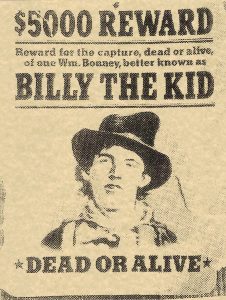 and Silver City, New Mexico. His mother died in 1874 and Billy the Kid…who went by a variety of names throughout his life, including Kid Antrim and William Bonney…turned to crime soon afterward. I guess that explains the decision to steal a basket of laundry. There are criminals who start out as good people, and then circumstances in their life force them to do things they might not otherwise do. Then, once they are into it, there is no going back. Billy the Kid became a horse thief in Arizona before returning to New Mexico, where he hooked up with a gang of gunslingers and cattle rustlers involved in the notorious Lincoln County War between a rival rancher and merchant factions in Lincoln County in 1878. It would be this time period that would eventually get him a death sentence.
and Silver City, New Mexico. His mother died in 1874 and Billy the Kid…who went by a variety of names throughout his life, including Kid Antrim and William Bonney…turned to crime soon afterward. I guess that explains the decision to steal a basket of laundry. There are criminals who start out as good people, and then circumstances in their life force them to do things they might not otherwise do. Then, once they are into it, there is no going back. Billy the Kid became a horse thief in Arizona before returning to New Mexico, where he hooked up with a gang of gunslingers and cattle rustlers involved in the notorious Lincoln County War between a rival rancher and merchant factions in Lincoln County in 1878. It would be this time period that would eventually get him a death sentence.
Billy the Kid wasn’t a big man, but rather had a slender build and prominent crooked front teeth. He loved to sing, and I have to wonder what he might have become had he chosen singing over crime. Nevertheless, after the Lincoln County War, he went on the lam and continued his outlaw’s life, stealing cattle and horses, gambling 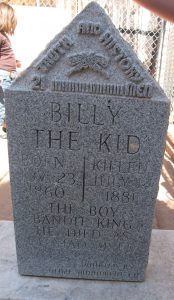 and killing people. His crimes earned him a bounty on his head and he was eventually captured and indicted for killing a sheriff during the Lincoln County War.
and killing people. His crimes earned him a bounty on his head and he was eventually captured and indicted for killing a sheriff during the Lincoln County War.
Sentenced to hang for his crime, Billy the Kid managed to escape from jail one more time, murdering two deputies in the process. His freedom was short lived, however, as Sheriff Pat Garrett caught up with him at Fort Sumner, New Mexico, on July 14, 1881, and fatally shot him. Billy’s legend grew following his short life and violent death. Today he is a famous symbol of the Old West, along with such men as Kit Carson, Jesse James, Wild Bill Hickok, Doc Holliday and Wyatt Earp, and like many criminals of the past, his story has been romanticized in numerous films, books, TV shows and songs. Each year, tourists visit the town of Fort Sumner, located about 160 miles southeast of Albuquerque, to see the Billy the Kid Museum and gravesite.

 My nephew, Jason Sawdon is a Wyoming Highway Patrolman by trade, and a very good one. He was even voted “Trooper of the Year” in 2015. Jason is very proud of his role as a Wyoming Highway Patrolman, but that is not what he considers to be his most important job. His most important job is being a husband to my niece, Jessi, and Daddy to their daughter, Adelaide. For Jason, having a family is the ultimate life success story. Your job is just your job, and while you are good at it, and like what you are doing, it is still your job, and it will never be as important as your family.
My nephew, Jason Sawdon is a Wyoming Highway Patrolman by trade, and a very good one. He was even voted “Trooper of the Year” in 2015. Jason is very proud of his role as a Wyoming Highway Patrolman, but that is not what he considers to be his most important job. His most important job is being a husband to my niece, Jessi, and Daddy to their daughter, Adelaide. For Jason, having a family is the ultimate life success story. Your job is just your job, and while you are good at it, and like what you are doing, it is still your job, and it will never be as important as your family.
This first year of being Adelaide’s daddy has been a busy one, because as you know, babies really do keep their parents busy. Having a child changes a person’s whole identity. Jason has gone from being Jason Sawdon, Wyoming Highway Patrolman, to being Adelaide’s Daddy. That will become more clear as time goes on, because all of her little friends will say, “You’re Adelaide’s daddy, right?” And that doesn’t really change…ever. Even when the kids are grown, people will ask you if you are their parent, so it is a new identity for the parent. And it’s one that they don’t mind, because that is their baby, and it’s really cool to have people acknowledge that. The older they get, the more surprising it is, but I still get asked if I am Corrie or Amy’s mom, so it’s a fun, and it’s definitely a lifelong name change for the parents.
Jason has been taking his family to do lots of fun things. They have spent time on the mountain, hiking and 
 camping, and they have gone to visit the grandparents that live in Michigan. Adelaide is a part of a big family, on both her parents sides, so it’s important that she get to know everyone. Adelaide had a great time visiting with everyone, and getting to know her cousins. Of course, the first year being a daddy carries a lot of responsibility. There is much to teach your child, and lately, the focus has been on teaching Adelaide to walk. That is an important part of a child’s life, and a fun part of parenting. Jason and Jessi are great teachers, and of course, Adelaide is a model student, so she is now an accomplished walker. I know that the future will be a wonderful experience for Adelaide’s Daddy, and I look forward to watching them experience life. Today is Jason’s birthday. Happy birthday Jason!! Have a great day!! We love you!!
camping, and they have gone to visit the grandparents that live in Michigan. Adelaide is a part of a big family, on both her parents sides, so it’s important that she get to know everyone. Adelaide had a great time visiting with everyone, and getting to know her cousins. Of course, the first year being a daddy carries a lot of responsibility. There is much to teach your child, and lately, the focus has been on teaching Adelaide to walk. That is an important part of a child’s life, and a fun part of parenting. Jason and Jessi are great teachers, and of course, Adelaide is a model student, so she is now an accomplished walker. I know that the future will be a wonderful experience for Adelaide’s Daddy, and I look forward to watching them experience life. Today is Jason’s birthday. Happy birthday Jason!! Have a great day!! We love you!!
 These days, patriotism seems to be constantly under fire. The nation has basically taken sides on the issue. There are those who hate this country and all it stands for, and those who love this country despite its faults and any negative historical events. I am a patriot, and it is my belief that history is history, mistakes and all. It can’t be changed by tearing down a few statues, and certainly not by stomping on our flag. The patriots of this time feel the same as the patriots of the Vietnam era…”Our Flag, Love it or Leave.” I find it strange to think that this era is really no different than that era, or any other era of American history, or in fact, in the history of any nation. There are those who love their nation and are loyal to it, and those who tend to blow with the wind…only showing faithfulness when it suits their own agenda. In my opinion and the opinion of every patriot, these people who turn on our country just because things aren’t going their way, are traitors, and should be treated as such.
These days, patriotism seems to be constantly under fire. The nation has basically taken sides on the issue. There are those who hate this country and all it stands for, and those who love this country despite its faults and any negative historical events. I am a patriot, and it is my belief that history is history, mistakes and all. It can’t be changed by tearing down a few statues, and certainly not by stomping on our flag. The patriots of this time feel the same as the patriots of the Vietnam era…”Our Flag, Love it or Leave.” I find it strange to think that this era is really no different than that era, or any other era of American history, or in fact, in the history of any nation. There are those who love their nation and are loyal to it, and those who tend to blow with the wind…only showing faithfulness when it suits their own agenda. In my opinion and the opinion of every patriot, these people who turn on our country just because things aren’t going their way, are traitors, and should be treated as such.
There have been a number of traitors in our nations history, and I’m sure there will be many more, but one of the most famous of them all was Benedict Arnold. On this day in 1780, during the American Revolution, an American General named Benedict Arnold met with a British Major named John Andre to discuss the treasonous act of handing over West Point to the British. In return Arnold was promised of a large sum of money and a high position in the British army. The plot was foiled and Arnold, who was once considered an American hero, became synonymous with the word “traitor.” Benedict Arnold was not always a low life traitor. He was actually  born into a well-respected family in Norwich, Connecticut, on January 14, 1741. He apprenticed with an apothecary and was a member of the militia during the French and Indian War from 1754 to 1763. Later, he became a successful trader and then joined the Continental Army when the Revolutionary War broke out between Great Britain and its 13 American colonies in 1775. When the war ended in 1783, the colonies had won their independence from Britain and formed a new nation…the United States.
born into a well-respected family in Norwich, Connecticut, on January 14, 1741. He apprenticed with an apothecary and was a member of the militia during the French and Indian War from 1754 to 1763. Later, he became a successful trader and then joined the Continental Army when the Revolutionary War broke out between Great Britain and its 13 American colonies in 1775. When the war ended in 1783, the colonies had won their independence from Britain and formed a new nation…the United States.
During the war, Benedict Arnold proved himself a brave and skillful leader, helping Ethan Allen’s troops capture Fort Ticonderoga in 1775 and then participating in the unsuccessful attack on British Quebec later that year, which earned him a promotion to brigadier general. Arnold distinguished himself in campaigns at Lake Champlain, Ridgefield and Saratoga, and gained the support of George Washington. However, Arnold also had some enemies within the military and in 1777, five men of lesser rank were promoted over him. I see that there were those who were not fooled by his presumed loyalty. Over the course of the next few years, Arnold married for a second time. He and his new wife lived a lavish lifestyle in Philadelphia, accumulating a large amount of debt. The debt and the resentment Arnold felt over not being promoted faster were the motivating factors in his decision to become a turncoat.
In 1780, Arnold was given command of West Point, an American fort on the Hudson River in New York, and future home of the United States military academy, which was established in 1802. Arnold contacted Sir Henry 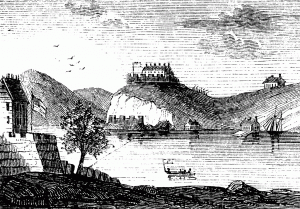 Clinton, head of the British forces, and proposed handing over West Point and his men. On September 21, 1780, Arnold met with Major John Andre and made his traitorous pact. Thankfully, the conspiracy was uncovered and Andre was captured and executed. Arnold, the former American patriot turned traitor, fled to the enemy side and went on to lead British troops in Virginia and Connecticut. He later moved to England, though he never received all of what he’d been promised by the British. He died in London on June 14, 1801, having never realized the greatness he thought he would achieve. Now, when people think of a traitor, they often call them a Benedict Arnold. It is a huge insult to be called that.
Clinton, head of the British forces, and proposed handing over West Point and his men. On September 21, 1780, Arnold met with Major John Andre and made his traitorous pact. Thankfully, the conspiracy was uncovered and Andre was captured and executed. Arnold, the former American patriot turned traitor, fled to the enemy side and went on to lead British troops in Virginia and Connecticut. He later moved to England, though he never received all of what he’d been promised by the British. He died in London on June 14, 1801, having never realized the greatness he thought he would achieve. Now, when people think of a traitor, they often call them a Benedict Arnold. It is a huge insult to be called that.

 So much has happened this past year for my grandniece, Hattie Parmely. For one thing, she is no longer the baby of the family…now she is a big sister to her little brother, Bowen Parmely. Hattie has really enjoyed her little brother, because he is the baby, and Hattie loves babies…all kinds of babies. I think her love of babies has come from the fact that her family lives on a farm, and they raise chickens, cows, goats, and horses. There are always babies in that mix.
So much has happened this past year for my grandniece, Hattie Parmely. For one thing, she is no longer the baby of the family…now she is a big sister to her little brother, Bowen Parmely. Hattie has really enjoyed her little brother, because he is the baby, and Hattie loves babies…all kinds of babies. I think her love of babies has come from the fact that her family lives on a farm, and they raise chickens, cows, goats, and horses. There are always babies in that mix.
Of course, Hattie loves being the little sister too, because she has learned so many things from her big sister, Reagan. You see, Reagan has a car…it’s a toy of course, but it goes on it’s own power. In reality, I think the car belongs to both girls, but Reagan drives it the most. Reagan takes Hattie for rides around the farm, and helps her get up in the haystacks, shows her how to do the farm work, and how to be careful with the babies. Hattie knows that Reagan has had soooo much more experience with these things, since she is almost five. and Hattie is just turning three today. Soon, it will be both Reagan and Hattie that will be teaching Bowen all of the things he needs to know…whether he wants them to teach him or not, because he is the little brother, and that’s what big sisters do.
Hattie and Reagan are big helpers around the farm, and at their grandparents houses. One set of grandparents lives next door, and owns part of the animals that the girls take care of, and the other set has a cabin on the mountain, and they often need help cutting wood for the fire. These big strong girls get right out there and help get the job done. Hattie and Reagan have great imaginations, and they are always up to something. They might play house in the hay, or practice their milking skills…on each other, pretend, of course. They love life on 
 the farm, and they are tough enough to clean up after the animals, collect eggs, feed the animals, and whatever else their parents might need them to do. It’s all part of farming, and they are really into it. They are always busy doing something, in fact, I’m told that the only time Hattie will sit still is if you put a baby in her arms. I can’t say that I think that is a bad thing. Being active is good and holding babies is great, so…you go Hattie!! Today is Hattie’s 3rd birthday. Happy birthday Hattie!! Have a great day!! We love you!!
the farm, and they are tough enough to clean up after the animals, collect eggs, feed the animals, and whatever else their parents might need them to do. It’s all part of farming, and they are really into it. They are always busy doing something, in fact, I’m told that the only time Hattie will sit still is if you put a baby in her arms. I can’t say that I think that is a bad thing. Being active is good and holding babies is great, so…you go Hattie!! Today is Hattie’s 3rd birthday. Happy birthday Hattie!! Have a great day!! We love you!!
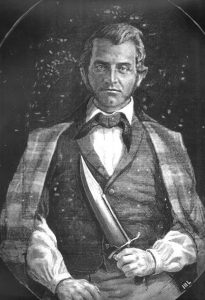 Duels weren’t always fought with guns, in fact most fights in the Old West weren’t really fought by duel or shootout. Most were actually drunken brawls that ended in a gunfire, but some fights, duels or brawls were fought with knives, and among the most famous knife fighters was a man named Jim Bowie. Many people think that he invented the Bowie knife, but in reality, the Bowie knife was invented by Jim’s equally belligerent brother Rezin Bowie. Resin came up with the design after nearly being killed in a vicious knife fight. Nevertheless, on September 19, 1827, it was Jim Bowie who made the knife famous when he killed a banker in Alexandria, Louisiana, using an early version of the Bowie knife. The Bowie brothers engaged in more fights than the typical frontiersman of the day, but such violent duels were not uncommon events on the untamed margins of American civilization. I guess some people just liked the bloody
Duels weren’t always fought with guns, in fact most fights in the Old West weren’t really fought by duel or shootout. Most were actually drunken brawls that ended in a gunfire, but some fights, duels or brawls were fought with knives, and among the most famous knife fighters was a man named Jim Bowie. Many people think that he invented the Bowie knife, but in reality, the Bowie knife was invented by Jim’s equally belligerent brother Rezin Bowie. Resin came up with the design after nearly being killed in a vicious knife fight. Nevertheless, on September 19, 1827, it was Jim Bowie who made the knife famous when he killed a banker in Alexandria, Louisiana, using an early version of the Bowie knife. The Bowie brothers engaged in more fights than the typical frontiersman of the day, but such violent duels were not uncommon events on the untamed margins of American civilization. I guess some people just liked the bloody 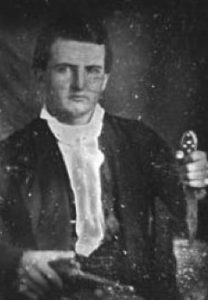 challenge more than other people. Personally, I don’t think that I would have the stomach for taking a life in such a manner, but then most of us really don’t want to kill someone at all. The Bowie brothers seemed to thrive on killing and fighting.
challenge more than other people. Personally, I don’t think that I would have the stomach for taking a life in such a manner, but then most of us really don’t want to kill someone at all. The Bowie brothers seemed to thrive on killing and fighting.
As time went on, most frontiersmen preferred knives to guns for fighting. I suppose they decided that they had a better chance against a knife than a gun. The Bowie knife quickly became one of the favorites, probably because it was scary all by itself. Often, when the Bowie knife was pulled out, the opponent had to quickly consider whether or not the fight was really worth the risk. The Bowie knife often discouraged many a would-be robber or attacker. The designs varied somewhat, but the typical Bowie knife sported a 9 to 15 inch blade sharpened only on one side for  much of its length, though the curved tip was sharpened to a point on both sides. The double-edged tip made the knife an effective stabbing weapon, while the dull-edge combined with a brass hand guard allowed the user to slide a hand down over the blade as needed. It was the perfect knife for close-quarter fighting, and quickly became the weapon of choice for many westerners before the reliable rapid-fire revolver took its place in the post-Civil War era.
much of its length, though the curved tip was sharpened to a point on both sides. The double-edged tip made the knife an effective stabbing weapon, while the dull-edge combined with a brass hand guard allowed the user to slide a hand down over the blade as needed. It was the perfect knife for close-quarter fighting, and quickly became the weapon of choice for many westerners before the reliable rapid-fire revolver took its place in the post-Civil War era.
One would think that the Bowie brothers were outlaws, but in reality, they weren’t. They were landowners, and like many people in the Old West, sometimes they had to defend themselves. I suppose that as their fame grew, the need to defend themselves became a more common occurrence. While Rezin Bowie invented the Bowie knife, it was Jim Bowie who ultimately brought the knife its fame. After his first fight, men started going to a blacksmith to ask them to make a knife like Jim Bowie’s knife.
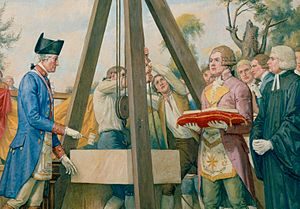
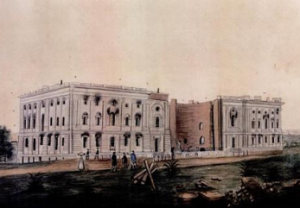 Most people know what the United States Capitol building looks like, and many have seen it, and even been inside it, but I wonder how many people know that is almost wasn’t completed. Yes, you heard me right. I almost wasn’t completed. As a young nation, the United States had no permanent capitol, and Congress met in eight different cities, including Baltimore, New York and Philadelphia, before 1791. In 1790, Congress passed the Residence Act, which gave President Washington the power to select a permanent home for the federal government. The following year, he chose what would become the District of Columbia from land that had been provided by Maryland. Washington picked three commissioners to oversee the capital city’s development and they in turn chose French engineer Pierre Charles L’Enfant to come up with the design. However, L’Enfant clashed with the commissioners and was fired in 1792. A design competition was held, and a Scotsman named William Thornton submitted the winning entry.
Most people know what the United States Capitol building looks like, and many have seen it, and even been inside it, but I wonder how many people know that is almost wasn’t completed. Yes, you heard me right. I almost wasn’t completed. As a young nation, the United States had no permanent capitol, and Congress met in eight different cities, including Baltimore, New York and Philadelphia, before 1791. In 1790, Congress passed the Residence Act, which gave President Washington the power to select a permanent home for the federal government. The following year, he chose what would become the District of Columbia from land that had been provided by Maryland. Washington picked three commissioners to oversee the capital city’s development and they in turn chose French engineer Pierre Charles L’Enfant to come up with the design. However, L’Enfant clashed with the commissioners and was fired in 1792. A design competition was held, and a Scotsman named William Thornton submitted the winning entry.
Then, on this day, September 18, 1793, Washington laid the Capitol’s cornerstone and the lengthy construction process, which would involve a line of project managers and architects, got under way. One would think that is due time, the capitol building would be finished, but in reality, it took almost a century to finish…almost 100 years!! During those years, architects came and went, the British set it on fire, and it was called into use during the Civil War. In 1800, Congress moved into the Capitol’s north wing. In 1807, the House of Representatives moved into the building’s south wing, which was finally finished in 1811. During the War of 1812, the British invaded Washington DC. They set fire to the Capitol on August 24, 1814. Thankfully, a rainstorm saved the building from total destruction. Congress met in nearby temporary quarters from 1815 to 1819. In the early 1850s, work began to expand the Capitol to accommodate the growing number of Congressmen. The Civil War halted construction in 1861 while the Capitol was used by Union troops as a hospital and barracks. Following the war, expansions and modern upgrades to the building continued into the next century.
Today, the Capitol building, with its famous cast-iron dome and important collection of American art, is part of the Capitol Complex, which includes six Congressional office buildings and three Library of Congress buildings, all developed in the 19th and 20th centuries. The Capitol, which is visited by 3 million to 5 million people each 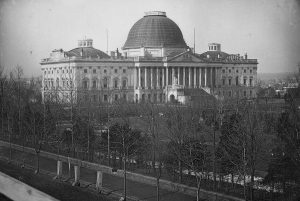
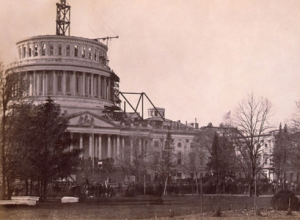 year, has 540 rooms and covers a ground area of about four acres. I’m sure that those who visit the United States Capitol Building probably hear all about it strange past and its construction history, but maybe not. I suppose that it depends on what the tour guide finds interesting. Personally, I like the unusual construction. Thankfully, the United States Capitol did finally get built and has become the beautiful building we know today.
year, has 540 rooms and covers a ground area of about four acres. I’m sure that those who visit the United States Capitol Building probably hear all about it strange past and its construction history, but maybe not. I suppose that it depends on what the tour guide finds interesting. Personally, I like the unusual construction. Thankfully, the United States Capitol did finally get built and has become the beautiful building we know today.

 A few days ago…September 13, 2017, to be exact, Greenville, North Carolina got a new citizen. Her name is Mackenzie Rose Moore, and she is absolutely beautiful. Mackenzie decided to arrive a little over two weeks before her due date, and once she made that decision, she took immediate action. Her mommy, my niece, Lindsay Moore was only in labor thirteen hours and twenty minutes…very fast for the first baby, but Mackenzie was in a hurry to meet her parents. Mackenzie’s daddy, Shannon Moore is the special teams coach at Eastern Carolina University, and so Mackenzie knew that she had to start getting to the games to show her support for her daddy, after all, she was going to be Daddy’s Girl. My guess is that she will be one of his biggest cheerleaders. In fact, she has been working on her cheer moves, and her daddy has already had her visit the sidelines to meet the team…and they all love their newest little cheerleader. Mackenzie’s daddy couldn’t possibly be any more proud of her. She is his little princess…and that’s as it should be.
A few days ago…September 13, 2017, to be exact, Greenville, North Carolina got a new citizen. Her name is Mackenzie Rose Moore, and she is absolutely beautiful. Mackenzie decided to arrive a little over two weeks before her due date, and once she made that decision, she took immediate action. Her mommy, my niece, Lindsay Moore was only in labor thirteen hours and twenty minutes…very fast for the first baby, but Mackenzie was in a hurry to meet her parents. Mackenzie’s daddy, Shannon Moore is the special teams coach at Eastern Carolina University, and so Mackenzie knew that she had to start getting to the games to show her support for her daddy, after all, she was going to be Daddy’s Girl. My guess is that she will be one of his biggest cheerleaders. In fact, she has been working on her cheer moves, and her daddy has already had her visit the sidelines to meet the team…and they all love their newest little cheerleader. Mackenzie’s daddy couldn’t possibly be any more proud of her. She is his little princess…and that’s as it should be.
I love that my niece, Lindsay gets to work from home, because that means that little Mackenzie Rose will get to  spend lots of time with her mommy, doing all the girly things like shopping, manicures, and hair styling. She and her mommy will be the best of friends, and will work together to make a wonderful home for her daddy. Mackenzie will learn all about good nutrition and exercise from her mommy, and they will have lots of fun playing, going for jogs…with Mackenzie in a stroller, of course…at least at first. When I look at Lindsay with Mackenzie, I can just feel the love between them, and it is so special. I am so happy for Lindsay and Shannon. Their family has now taken on a new dimension. Their love has gone to the next level. It has expanded into a whole new person, and that is very special.
spend lots of time with her mommy, doing all the girly things like shopping, manicures, and hair styling. She and her mommy will be the best of friends, and will work together to make a wonderful home for her daddy. Mackenzie will learn all about good nutrition and exercise from her mommy, and they will have lots of fun playing, going for jogs…with Mackenzie in a stroller, of course…at least at first. When I look at Lindsay with Mackenzie, I can just feel the love between them, and it is so special. I am so happy for Lindsay and Shannon. Their family has now taken on a new dimension. Their love has gone to the next level. It has expanded into a whole new person, and that is very special.
Mackenzie has also been getting to know her grandma, my sister Allyn Hadlock this week. The minute Allyn knew that Lindsay was in labor, she had planned to get on a plane headed for 
 North Carolina, but Mackenzie just couldn’t wait that long. Allyn was so excited to be a grandma again, and she had hoped to be there before the baby’s birth, but she would have had to go in Star Trek style…Beam me up Scotty…if she was going to make it in time for this speedy little girl. Nevertheless, before her first day was over, Mackenzie got to meet her grandma. It was a late day, for sure, but Mackenzie Rose had to stay awake to meet her grandma. Some things are really important, and meeting grandparents is pretty close to the top of the list…right behind meeting one’s parents. We are all so excited for Lindsay and Shannon on their new little baby girl, and we can’t wait to meet her when they visit Casper. We love you little Mackenzie Rose Moore!!
North Carolina, but Mackenzie just couldn’t wait that long. Allyn was so excited to be a grandma again, and she had hoped to be there before the baby’s birth, but she would have had to go in Star Trek style…Beam me up Scotty…if she was going to make it in time for this speedy little girl. Nevertheless, before her first day was over, Mackenzie got to meet her grandma. It was a late day, for sure, but Mackenzie Rose had to stay awake to meet her grandma. Some things are really important, and meeting grandparents is pretty close to the top of the list…right behind meeting one’s parents. We are all so excited for Lindsay and Shannon on their new little baby girl, and we can’t wait to meet her when they visit Casper. We love you little Mackenzie Rose Moore!!

 Sometimes, I find myself quite shocked to think that I could have children who have been married more than twenty years. I know that seems odd, and that I should be used to it, but it just doesn’t seem possible…and yet it is. Twenty two years ago today, my youngest daughter, Amy Royce walked down the isle, and into the arms of the love of her life, Travis Royce. So much has changed since that day. Amy and Travis have two beautiful, grown children, Shai and Caalab, and they all live in the Bellingham, Washington area. Living near the water was always a dream of Amy’s, and Travis has always loved Washington state too, so it’s a dream come true.
Sometimes, I find myself quite shocked to think that I could have children who have been married more than twenty years. I know that seems odd, and that I should be used to it, but it just doesn’t seem possible…and yet it is. Twenty two years ago today, my youngest daughter, Amy Royce walked down the isle, and into the arms of the love of her life, Travis Royce. So much has changed since that day. Amy and Travis have two beautiful, grown children, Shai and Caalab, and they all live in the Bellingham, Washington area. Living near the water was always a dream of Amy’s, and Travis has always loved Washington state too, so it’s a dream come true.
I asked Amy if she ever dreamed that they would make it this far, and she said that she always knew they would. She kinda likes him, you know. I can see how that could be. They are very good together, and her latest Facebook profile picture says it all…captioned, “I love this maaaaaan!!” Their love for each other is quite obvious. You can see it in every picture they do together. That is something that really warms a mother’s heart. There is just something about knowing that your child is really loved that makes you feel so good about the relationship choice they have made. And I know that Amy and Travis have both made a wonderful choice…the perfect, made in Heaven kind of love.
Amy and Travis are both very social people, although Amy is a little more bashful than Travis is. Nevertheless, once she gets to know people, she really enjoys socializing. They are also very much alike in their sense of humor. I never really thought of Amy as being a funny girl, but she really seems to be these days. Maybe Travis has worn off on her. It had to be that way, because Travis has always been that way. He loves a good joke, and loves to make people laugh. That laughter is one thing that has always impressed me about the home that Travis created for his family. Every time I was there, I saw it…laughter. It was the norm in their home. The kids thrived on it, and they enjoy a good joke now too. I think that laughter makes a home warm 
 and cozy. And with Amy and Travis, you never knew what they were going to come up with next.
and cozy. And with Amy and Travis, you never knew what they were going to come up with next.
Twenty two years is a long time to be together these days, but when the home is filled with love and laughter, the years fly by. Suddenly, before you ever realized where they had gone, 22 years are in the past. The good news is that they know that they have the rest of their lives to enjoy being together. Today is Amy and Travis’ 22nd anniversary. Happy anniversary Amy and Travis!! Have a great day!! We love you!!

